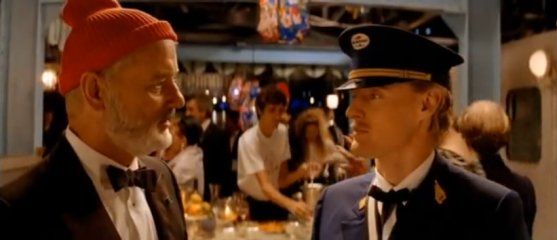This was to be our most ambitious adventure to date, and ultimately a tragic one.

What becomes of a storyteller who's lost the plot but isn't quite ready to face up to the fact that their creative energies are spent? That's the question at the heart of Wes Anderson's 2004 film The Life Aquatic with Steve Zissou, which follows a Jacques Cousteau-like oceanographer (Bill Murray) who's having a midlife crisis of epic proportions. Written by Anderson and Noah Baumbach -- making this the first Anderson film that wasn't co-written by Owen Wilson, who has yet to return to that fold -- the film opens at the Loquasto Film Festival, where Murray is premiering the first part of his latest documentary, in which beloved collaborator Seymour Cassel falls prey to a creature Murray dubs a "jaguar shark." Both he and the film are greeted with some skepticism, but he vows that he will have his revenge and document himself in the process of taking it.
In short order we're introduced to Team Zissou, which includes his wife (Anjelica Huston), the brains behind the operation, his right-hand man (Willem Dafoe), and his principal financier (Michael Gambon), who's trying his best to keep their ship, the Belafonte, afloat. At the same time, Murray is introduced to the 29-year-old Air Kentucky pilot who may very well be his son (Owen Wilson) and who's immediately offered a place on the team, much to the dismay of Dafoe, who sees his place at Murray's side being usurped. There are other interlopers along for the ride as well, namely a pregnant magazine journalist (Cate Blanchett) with an agenda and a bond-company stooge (Bud Cort) who's there to keep an eye on the budget. And rounding out the main cast is the incomparable Jeff Goldblum as Huston's ex-husband and Murray's nemesis, whose operation is infinitely better funded.
Speaking of which, with this film Anderson had the wherewithal to shoot at Cinecittà Studios, and he took full advantage of it. He also had a significant effects budget, part of which went to Henry Selick's unit, which employed stop-motion to animate the fanciful sea creatures (like the Crayon Ponyfish, the Sugar Crab, the Fluorescent Snapper, and the aforementioned Jaguar Shark) dreamed up by Anderson and Baumbach. As for the music -- always an important component of any Anderson film -- Brazilian singer Seu Jorge got all the attention for his Portuguese-language covers of various David Bowie songs, but just as important is Mark Mothersbaugh's original score, which I hope won't be his last for the director. I'm not holding my breath, though.